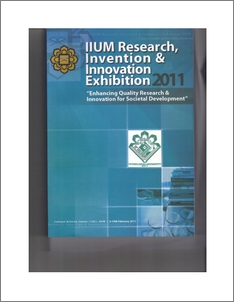Azahari, Nuraniza and Bakhtiar, M. Taher and Azahari, Ichwannuraniza and Arief Ichwan, Solachuddin Jauhari and Khattak, Muhammad Muzaffar Ali Khan
(2011)
Effects of spices and herbal extract on Preadipocyte Cell Differentiation:preliminary results.
In: IIUM Research, Invention and Innovation Exhibition (IRIIE) 2011, 9-10 February 2011, IIUM, Kuala Lumpur.
(Unpublished)
![[img]](http://irep.iium.edu.my/style/images/fileicons/application_pdf.png)  Preview |
|
PDF (Effects of spices and herbal extract on Preadipocyte Cell Differentiation:preliminary results)
Download (390kB)
| Preview
|
Abstract
Type 2 diabetes is multifactorial and polygenic diseases associated with an increased risk of mortality and morbidity. The causes and cure of diabetes are not entirely clear but diet certainly plays an important role in the etiology of type 2 diabetes. Recent research has shown that there is negative association between adipokines and prevalence of type 2 diabetes. Therefore, the normal amounts of the adipokines are considered important for the normal functioning of the body (glucose homeostasis). This project was designed to study the effect of selected Malaysian spices and herbs (based on the traditional use in the treatment of type 2 diabetes). The spices and herbs namely Syzgium colyanthum, Peronema canescens, Orthosiphon stamineus, Lagerostroemia speciosa, Momordica charantia, Tinospara crispa, Pithecellobium jiringa, Cinnamomum zeylanicum, and Andrographis paniculata were procured through local supplier and water extracts were obtained and freeze dried. The extracts effects were studied on cell growth using an in-vitro model of 3T3-L1 adipocyte cell line. The preliminary test carried out was to know the effect of the listed extracts to induce changes from preadipocyte to adipocyte. This test was performed by using a mixture of dexamethasone, 1-isobutyl-3-methylxantine (IBMX) and the extracts from the aforementioned spices and herbs. Preliminary results indicate that among the extracts used, Orthosiphon stamineus and Lagerostroemia speciosa had stronger activity/effect on preadipocyte differentiation. This is of clinical importance both for type 2 diabetes as well as for obesity. The extracts from the same sources will be incorporated to preadipocytes culture for further tests including protein analysis, adipogenesis and adipolysis assays using appropriate kits. Lastly, the adipocytes will be assessed for adiponectin and leptin protein concentration using competitive colorimetric enzyme-linked immunosorbent assay (ELISA) kit known as the B-bridge adiponectin ELISA kit method. Preliminary results indicate that Orthosiphon stamineus and Lagerostroemia speciosa induce cell differentiation in preadipocytes which will be further investigated.
Actions (login required)
 |
View Item |


 Download Statistics
Download Statistics Download Statistics
Download Statistics